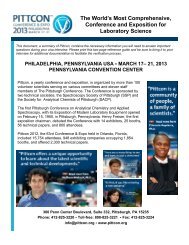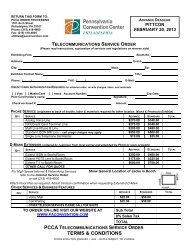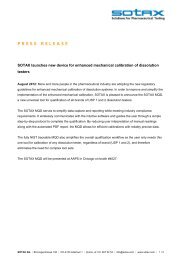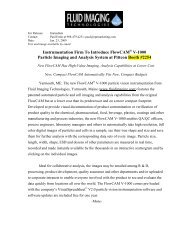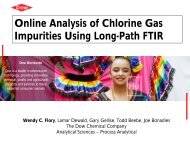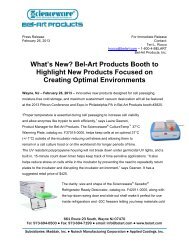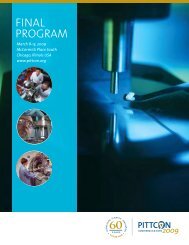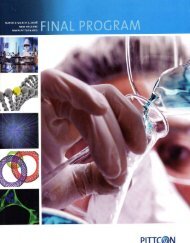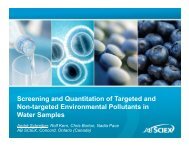2012 Final Program - Pittcon
2012 Final Program - Pittcon
2012 Final Program - Pittcon
Create successful ePaper yourself
Turn your PDF publications into a flip-book with our unique Google optimized e-Paper software.
PITTCON <strong>2012</strong> EXHIBITOR SEMINAR LISTING<br />
EXHIBITOR NAME ROOM # DESCRIPTION<br />
2:00 p.m.<br />
Introducing the New ICAP-Q ICP-MS System<br />
Discover the dramatically different Thermo Scientific iCAP Q ICP-MS system. An all-new ultra-compact bench-top design, the iCAP Q features a<br />
revolutionary new interface that maximizes both sensitivity and matrix tolerance, a unique ion focusing system that delivers best in class signal-to-noise<br />
performance, the revolutionary new QCell with flatapole technology & low mass filter for unparalleled interference removal and the new QTegra software<br />
platform that enables one-click operation, virtually eliminating the learning curve.<br />
Tosoh Biosciences SR 04 Tuesday, March 13, <strong>2012</strong><br />
10:00 a.m.<br />
A brief overview of the analysis of biomolecules using gel filtration chromatography (GFC): common issues in method development and<br />
troubleshooting.<br />
Atis Chakrabarti, Ph.D., Manager, Technical Services, Laboratory Products, Tosoh Bioscience LLC<br />
TSKgel ® size exclusion columns are known worldwide for their reliability and suitability for the analysis of proteins, peptides, and other biological<br />
macromolecules. In 1977 Tosoh introduced TSKgel SW series high performance gel filtration columns which have become synonymous with analyzing<br />
protein molecular weight in the field of biotechnology. TSKgel G3000XL columns are the industry standard for quality control of monoclonal antibodies.<br />
The focus of this talk will feature an overview of TSKgel SW series gel filtration columns available from Tosoh Bioscience as well as a discussion of column<br />
lifetime issues and common method development and troubleshooting issues encountered in size exclusion chromatography.<br />
11:00 a.m.<br />
Detection of Protein Heterogeneity by HPLC<br />
Dr. Kawai, Separation Center, TOSOH Corporation<br />
Antibodies and recombinant proteins are now widely used for therapeutic treatment, thus the evaluation of the heterogeneity of a therapeutic antibody is<br />
essential during development, stability testing and in the quality control of the final product. In this presentation the detection and separation of protein<br />
heterogeneity by HPLC using four different modes of chromatography is demonstrated.<br />
High resolution nonporous resin columns for Ion Exchange Chromatography (IEX) and Hydrophobic Interaction Chromatography (HIC) were used for the<br />
analysis of antibodies, showing a sensitivity level of 1 residue difference of the proteins. Using size exclusion chromatography (SEC) columns, baseline<br />
separation was achieved for a monomer (150 kDa) and a dimer (300 kDa) of a human monoclonal antibody. Papain and pepsin digested antibodies were<br />
resolved to separate Fc, Fab and intact protein to baseline resolution, also by SEC. A new reversed phase chromatography (RPC) column with a large pore<br />
size of 300 Å is shown to be applicable for the evaluation of protein heterogeneity.<br />
2:00 p.m.<br />
Bridging the gap in polymer characterization: Single- and multi-detector SEC<br />
Amandaa Brewer, Ph.D., GPC Technical Specialist, Tosoh Bioscience LLC<br />
Since its inception, the principle use of size exclusion chromatography (SEC) has been to determine the molar mass averages and distributions of natural<br />
and synthetic polymers. In general these properties have been characterized through the application of calibration curves via single-detector<br />
instrumental set-ups, e.g. SEC-refractive index (RI). Over the years as the complexity of polymers has increased, the ability to obtain accurate and precise<br />
distributions of both their physical and chemical properties have piloted a new era of polymer analysis: multi-detector SEC.<br />
In this presentation polymer characterization via single- and multi-detector SEC, namely the coupling of SEC to various combinations of RI, UV-Vis, multiangle<br />
light scattering (MALS), and differential viscometry (VISC), will be discussed. In addition, an overview of both multi-detector technologies as well as<br />
applications of natural and synthetic polymers will be provided.<br />
3:00 p.m.<br />
Improved GPC Performance from Multiple Pore Size Chromatography Particle Technology and an Excel-based Column Selection Tool<br />
Joe Machamer, GPC Marketing Manager, Tosoh Bioscience LLC<br />
A novel approach to solve the linearity problems of mixed bed and multiple columns of different pore sizes linked together was developed by Tosoh<br />
scientists and is incorporated in TSKgel SuperMultiporeHZ columns. These columns are packed with small particles of uniform size and synthesized with a<br />
broad distribution of pore sizes. This novel approach creates a linear calibration curve within each particle. Therefore, columns with an extended linear<br />
calibration curve can now be prepared without mixing particles of different pore sizes. Their small ID (4.6mm) and length (15cm) reduces solvent<br />
consumption and results in quick run times, and offers high throughput capabilities.<br />
Tosoh Bioscience has developed an Excel-based tool to plot calibration curves for various combinations of column pore size distributions. Benefits include<br />
accurate prediction of the behavior of combinations of mixed bed columns with individual pore size columns and trade-offs between run time and<br />
resolution.<br />
Wednesday, March 14, <strong>2012</strong><br />
10:00 a.m.<br />
Bridging the gap in polymer characterization: Single- and multi-detector SEC<br />
Amandaa Brewer, Ph.D., GPC Technical Specialist, Tosoh Bioscience LLC<br />
Since its inception, the principle use of size exclusion chromatography (SEC) has been to determine the molar mass averages and distributions of natural<br />
and synthetic polymers. In general these properties have been characterized through the application of calibration curves via single-detector<br />
instrumental set-ups, e.g. SEC-refractive index (RI). Over the years as the complexity of polymers has increased, the ability to obtain accurate and precise<br />
distributions of both their physical and chemical properties have piloted a new era of polymer analysis: multi-detector SEC.<br />
In this presentation polymer characterization via single- and multi-detector SEC, namely the coupling of SEC to various combinations of RI, UV-Vis, multiangle<br />
light scattering (MALS), and differential viscometry (VISC), will be discussed. In addition, an overview of both multi-detector technologies as well as<br />
applications of natural and synthetic polymers will be provided.<br />
108



